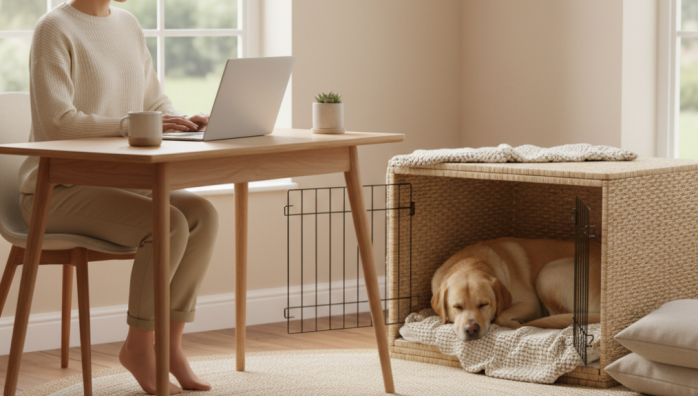Crate Training to Ease Pet Anxiety
by admin in Pet Care Basics 17 - Last Update November 21, 2025

When I first transitioned to working from home, I pictured a blissful scene: my dog, Buster, snoozing peacefully at my feet all day. And for a while, it was like that. The problem started when I had to leave. A quick trip to the grocery store would result in a frantically worried pup. It dawned on me that he had become so accustomed to my constant presence that my absence, however brief, was triggering some serious separation anxiety. It was heartbreaking, and honestly, it made me anxious too. That\'s when I decided to revisit crate training, not as a \'cage,\' but as a safe, personal den for him.
Understanding the \'why\' behind the crate
I think many of us, myself included, initially have a negative association with crates. We see them as cages for punishment or confinement. My \'aha\' moment was realizing that for a dog, a den-like space can be incredibly comforting. It\'s a predictable, secure spot that is theirs and theirs alone. The goal isn\'t to lock them away; it\'s to build such a positive association with the crate that they choose to go in on their own to relax. Shifting my mindset from \'caging my dog\' to \'giving my dog a bedroom\' was the first and most critical step.
My step-by-step approach to positive crate association
This process was all about patience and positive reinforcement. Rushing it, as I learned the hard way at first, only creates fear. Here is the slow-and-steady method that worked wonders for Buster.
- Choosing the right sanctuary: I made sure the crate was just large enough for him to stand up, turn around, and lie down comfortably. Too big, and they might use one end as a toilet; too small, and it\'s restrictive. I opted for a wire crate because it felt more open, and I could cover it with a blanket to create that cozy den feel.
- Making it irresistible: I filled it with the softest bedding I could find and his favorite, most durable chew toys. Initially, the only time he got his most high-value treat—a puzzle toy filled with frozen pumpkin—was inside the crate with the door wide open.
- The open door policy: For the first week, the crate door never closed. I\'d toss treats in, praise him extravagantly when he went inside, and let him come and go as he pleased. The crate was just a wonderful new piece of furniture that dispensed snacks.
- Closing the door (for a second): Once he was comfortable, I started closing the door for just a few seconds while he was eating a treat, then immediately opening it before he could even think about getting anxious. I slowly increased this time from seconds to a minute or two, always staying in the room.
- Gradual departures: The final step was leaving the room for short periods, then eventually leaving the house for a 5-minute walk, and building from there. This took weeks, not days.
What didn\'t work for me (and what I learned)
My biggest mistake was trying to rush the \'leaving the house\' part. The first time I left him for 20 minutes, I came back to a whining, stressed-out dog. I had to go back a few steps and work on building his confidence for longer durations. It taught me to watch his body language, not the clock. A calm dog is the only sign of progress that matters.
Crate training and the remote work reality
The beauty of this for remote work is that the crate has become his designated \'do not disturb\' zone. When I have an important video call, I can give him a long-lasting chew in his crate, and he settles in happily. He\'s not on high alert, listening for my every move. He\'s learned to self-soothe and relax independently, even when I\'m just in the next room. This has been as beneficial for my focus as it has been for his anxiety. While this worked for us, every dog is an individual, so I always recommend chatting with your vet or a certified trainer to tailor an approach that\'s best for your furry friend.












